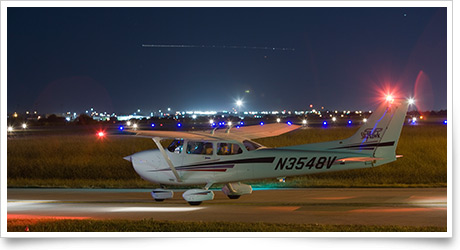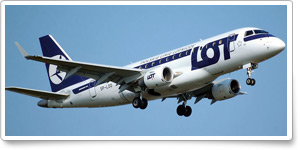June 21, 2013, issue of 'AOPA ePilot: Flight Training Edition' weekly newsletter
|
|||||
|
Lights for days and nights |
|||||
Training TipsLights for days and nights
What could be more startling than having a parked aircraft come to life just as you are passing by on the way to your own trainer? If no warning callout from the pilot is heard, and if no other indication such as a rotating beacon provides warning, you could find yourself uncomfortably close to that whirling propeller.
You wouldn’t want to be the pilot responsible for making pedestrians on the ramp jump. Avoiding that scenario means knowing the components of your aircraft’s lighting systems and using them to advance safety.
As a general rule, required equipment for day-VFR operation of small civil airplanes includes an approved anticollision light system, usually consisting of a rotating beacon, and possibly, strobe lights.
When must anticollision lights be on?
“Once that aircraft’s engine is started for the purpose of air navigation it is clear that FAR 91.209(b) requires that the aircraft’s anticollision lights be turned on,” wrote John Yodice in the September 2011 Pilot Counsel column. He added, “It is important to note that this interpretation addresses what is specifically required by the rule. The FAA is quick to offer a safety precaution. The FAA recommends, as a matter of safety, that the anticollision lights should be on before starting an engine or causing a propeller or rotor to move. That is a common practice among many pilots.”
For night VFR, approved position lights are also mandated. Position lights, explains the glossary of the Airplane Flying Handbook, are “lights on an aircraft consisting of a red light on the left wing, a green light on the right wing, and a white light on the tail.” Regulations “require that these lights be displayed in flight from sunset to sunrise.”
Many aircraft operators promote safety and give themselves a hedge against a dead aircraft battery by leaving their rotating beacon switch on when shutting down after a flight. If the pilot forgets to turn off the master switch, the continued operation of the rotating beacon could serve as a reminder. And at the next startup, the rotating beacon will begin to operate as soon as the master switch is turned on, alerting those nearby that the engine may soon come alive. Review Aeronautical Information Manual section 4-3-23 for a discussion of aircraft lighting systems operations, exceptions made in the interest of safety, and following manufacturers’ recommendations. Flight Training NewsMagnetic compass requirement dropped from private pilot taskThe FAA has reworded a navigation task in the Private Pilot Practical Test Standards (PTS) for Airplanes (FAA-S-8081-14B) to allow applicants to train and take their flight tests in aircraft equipped with magnetic direction sensing systems other than a magnetic compass. The action, explained in a note added May 30 to the current version of the PTS, will spare some flight training operators thousands of dollars in added costs to install compasses in training aircraft. Read more >> Comment period reopened on pilot testing, training standardsThe FAA has reopened the public comment period on an industry/government working group's draft Private Pilot and Instrument Rating Airman Certification Standards in response to several requests for more time to review the documents. Comments may be submitted until July 8. While stakeholders prepare their suggestions for the draft standards publications, about 130 comments submitted before the first comment window closed May 24 are being reviewed by the Airman Testing Standards and Training Working Group co-chaired by AOPA. Read more >> 12-year-old ready to buy airplaneAttendees could see gyrocopters and talk to highly experienced instructors about flying the aircraft. A lot can happen on a 10-minute first flight. According to 12-year-old Landon Howard, he grew wise beyond his years during a short flight in a Mooney over Frederick and Middletown, Md., June 8 during Learn to Fly Day at AOPA’s headquarters at Frederick Municipal Airport. Read more >> How can you get the most out of your flight training?Staying on track and keeping motivated are key components of a good flight training experience. How do you achieve and maintain that momentum? Join Flight Training Editor Ian J. Twombly and Technical Editor Jill W. Tallman for the July Facebook chat at 3 p.m. Eastern on Tuesday, July 2. The guest chatter will be Flight Training Contributing Editor Jamie Beckett, who writes frequently about the state of general aviation. As always, we welcome other questions about flight training. Visit the Flight Training Facebook page to set an email reminder or view transcripts of previous chats. SunState Aviation opens new training facilityFlorida-based SunState Aviation has opened a new training facility at Kissimmee Gateway Airport, according to Osceola News. The new facility offers a flight school, pilot shop, and a 10,000-square-foot, fully functional aircraft hangar. ‘Storm Week’ in reviewThunderstorm season is here—a great reason to review the Air Safety Institute’s free resources highlighted during the recent “Storm Week.” The Air Safety Institute encourages you to hone your thunderstorm avoidance knowledge with the institute’s recorded webinar “Thunderstorm Avoidance: ATC, Datalink, and You.” AOPA Foundation President Bruce Landsberg, Nexrad and datalink expert Dr. David Strahle, and Boise Tower air traffic controller Andy Marosvari discuss how ATC, weather briefers, and onboard weather avoidance tools can help you steer clear of thunderstorms and when it’s best to say no to a flight. Hear the recording >> Deadline for GA nonprofit grant application is nearDoes your nonprofit group have the right stuff to win a grant from the AOPA Foundation's Giving Back Program? The Foundation will be awarding grants of up to $10,000 each to nonprofit organizations doing charitable work through GA. Find out more and apply now as the July 1 grant application deadline is just around the corner. Learn more >> Training ResourcesSolo FAQNot long after your first solo, your instructor will authorize you to fly solo on a cross-country to another airport. You’ll have to take more responsibility for weather decisions, evaluating the wind, and other factors that until this point were made by, or in conjunction with, your flight instructor. Accurate information and a thorough understanding will help you to better execute these responsibilities. Get answers to your questions about solos.
Did you know that student pilots who join AOPA are three times more likely to complete their flight training? Membership includes unlimited access to aviation information by phone (800/USA-AOPA, weekdays from 8:30 a.m. to 8 p.m. Eastern time) or from Flight Training Online or AOPA Online. If you’re not already a member, join today and get the pilot’s edge. Login information is available online.
Open water survival, AOPA demands answersMonths of federal silence on general aviation aircraft searches by U.S. Customs and Border Protection agents have prompted a final demand for answers from AOPA, along with advice for pilots, and a plan to act if answers are not forthcoming. Also this week, a successful ditching is only half the battle: AOPA Live takes an in-depth look at open water survival training and offers some potentially life-saving tips and tricks. Watch a review of the latest David Clark headset, a brand-new model built for comfort. Rod Machado's regular "License to Learn" segment will explain flutter, and what that has to do with those little drain holes in aircraft control surfaces that you may have wondered about. AOPA Live This Week, June 20 >> Career PilotBoeing forecast sees demand for 35,000 new aircraftBoeing is projecting a demand for more than 35,000 new airplanes, valued at $4.8 trillion, over the next 20 years in its annual Current Market Outlook. Passenger traffic and cargo traffic are expected to grow 5 percent annually. “This forecast gives us confidence as we increase our production rates and invest in new products like the 777X and 787-10X,” said Randy Tinseth, vice president of marketing, Boeing Commercial Airplanes. “Airlines are demanding more efficiency and that is exactly what we'll be giving them.”
For more aviation career news, see the Flight Training website. Plane Spotter‘Ejets’ from Embraer
Training ProductsMyGoFlight unveils iPad Mini kneeboardThe new MyGoFlight iPad Kneeboard Folio, including clipboard, is a leather, rotating aviation kneeboard, lapboard, and everyday case for your iPad mini. The iPad is held by a form-fitting rotating cradle that your iPad simply clips into. All of the ports and controls remain accessible so the iPad can be charged, synced, and controlled when it is in its case. The cost is $159. ASA offers an instrument plotterASA’s instrument plotter features 12 scales for instrument charts, including a conversion scale for nautical and statute miles; holding patterns depicted for both standard and nonstandard entries; and compass roses allowing quick course and bearing information. The cost is $12.50.
Note: Products listed have not been evaluated by ePilot editors unless otherwise noted. AOPA assumes no responsibility for products or services listed or for claims or actions by manufacturers or vendors. Member BenefitsThe FAA and depressionCurrently only four antidepressant medications are acceptable to take and still receive medical certification: Celexa, Lexapro, Prozac, and Zoloft. Dr. Warren Silberman, former manager of FAA Aerospace Medical Certification, offers some guidelines for their use. Read more >> BlogsWhat do you bring to the table?Every airline pilot can fly—or at least it's assumed that the pilot can. When you are pursuing a job, the basic assumption is that you can aviate with a certain degree of competency, and that you are trainable. The real question for many interviewers is simple: What else do you bring to the table? What skills do you have? What problems can you help us solve? Read more >> Follow teens as they build two airplanesHockey or aviation? For high school student Aiden Muir, aviation trumps for the moment. He's helping other teens build two airplanes during Glasair's Two Weeks to Taxi program. Muir and the teens earned the experience after winning an aircraft design challenge sponsored by Build a Plane and the General Aviation Manufacturers Association. AOPA Technical Editor Jill W. Tallman is following them through the process. See how they’ve done each day this week. AOPA Career OpportunitiesEver dream of turning your passion for aviation into a career? We’re looking for a new business account manager II, renewal account manager II, aircraft analyst, director of corporate partnerships, email marketing specialist, member services representative, human resources assistant, software test and quality assurance analyst, and AOPA Live editor/graphic artist. To learn more about other AOPA career opportunities, visit AOPA Online. Community
AVIATION EVENTS & WEATHER
|
||||||||||||||||||||||||||||||||||||


 A plane spotter doing some research in the regional airline neighborhood of a bustling commercial-service airport is likely to notice a sleek jet that looms larger than the 50-seat commuter aircraft with which it often shares gate space. With its two engines mounted beneath winglet-tipped, swept wings, Embraer’s E-170, a member of the Brazilian manufacturer’s Ejet family “looks and feels like a mainline aircraft,” its maker says. E-170s in service in the US Airways Express fleet seat 69 passengers, with nine seats in a first class section and 60 more in coach.
A plane spotter doing some research in the regional airline neighborhood of a bustling commercial-service airport is likely to notice a sleek jet that looms larger than the 50-seat commuter aircraft with which it often shares gate space. With its two engines mounted beneath winglet-tipped, swept wings, Embraer’s E-170, a member of the Brazilian manufacturer’s Ejet family “looks and feels like a mainline aircraft,” its maker says. E-170s in service in the US Airways Express fleet seat 69 passengers, with nine seats in a first class section and 60 more in coach.


